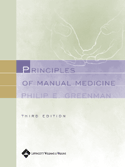Principles of Manual Medicine
ANNOTATION
Discusses myofascial release & functional techniques/incl. lumbopelvic
region/thoracic spine & rib cage/extremities/etc
FROM THE PUBLISHER
This practical resource opens up one of the most enduring, yet continually
evolving, areas of health care-manual medicine. With this informative text,
you'll learn the basic principles, specific techniques, and adjunct procedures
of the discipline - including the use of exercise for prevention and treatment
of disease and the use of other techniques to reduce pain.
SYNOPSIS
This reference describes the basic principles of manual medicine, its specific
techniques, and adjunct procedures such as the use of exercise. The
instructions recount each step of the techniques described, with the support of
about 1,000 clinical photographs. Chapters concentrate on the principles
governing particular aspects of care, and on particular techniques and
procedures. Greenman taught osteopathic manipulative medicine at Michigan State
University. Annotation ?004 Book News, Inc., Portland, OR
FROM THE CRITICS
Doody Review Services
Reviewer: Dana J. Lawrence, BS, BS, DC (National University of Health Sciences)
Description: This book provides a comprehensive overview of structural
diagnosis and manual medical procedures. The book looks at some general
approaches to manual medicine, and then presents a regional chapter-by-chapter
approach to the many procedures one can use in managing a variety of
conditions. This is a third edition and it has been a good number of years
since the second edition, so an update is much needed.
Purpose: The purpose is to present current information and answer questions
raised by those who use the first and second editions of this venerable book.
It is to convey over 50 years of experience in the use of manual medicine. A
clinically oriented book of manual medicine procedures is much needed, and Dr.
Greenman has met the objectives he set for himself in this latest edition.
Audience: This is designed for anyone who uses manual medical procedures, such
as osteopaths (the author is an osteopath), chiropractors, and physical
medicine specialists. The author is a leading clinical practitioner of manual
medicine who has been involved in teaching such procedures for nearly half a
century.
Features: There are three basic sections to this book. One covers general
principles and concepts, such as muscle energy technique, impulse and non-
impulse techniques and myofascial release. A second section is devoted to
techniques, and covers virtually all areas of the body. The final section looks
at the integration and correlation of procedures in managing both
musculoskeletal and organic conditions. What the book does well is present
eachindividual technique in detail, with illustrations and explanation given
for each procedure. There are ample illustrations provided, hundreds and
hundreds of photographs. The photo quality is not as crisp and clear as it
could be, perhaps due to the paper stock used. And rather than providing
references, each chapter provides a list of recommended readings.
Assessment: I own the last edition of this book, and find it rather useful.
This is a good new edition and I suspect I will use it every bit as much as the
last edition. In terms of books outside of chiropractic, where technique books
such as this are more common, this is a fine addition to the few books directed
more toward the medical field. I recommend it.
Booknews
A textbook in the basics of manual medicine, from the perspective of
osteopathics. The section on principles and concepts addresses such subjects as
structural diagnosis, manipulative prescription, vertebral motion, and the
techniques of muscle energy, mobilization with and without impulse, and
myofascial release. The section on procedures focuses successively on different
bodily regions. Annotation c.


